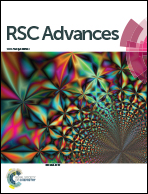Conversion of saccharides into levulinic acid and 5-hydroxymethylfurfural over WO3–Ta2O5 catalysts†
Abstract
Bimetallic oxide catalysts WO3–Ta2O5 are active in converting saccharides into 5-hydroxymethylfurfural (HMF) and levulinic acid (LA) in one-pot reactions. The product selectivity varies at different WO3 to Ta2O5 ratios. FTIR measurements indicate the presence of Lewis acid sites and the strength of the Lewis acid sites varies when the WO3 to Ta2O5 ratio changes. The result suggests that conversion of carbohydrates into HMF and LA can be realized using a single catalytic system by adjusting the catalyst's acidic properties.


 Please wait while we load your content...
Please wait while we load your content...